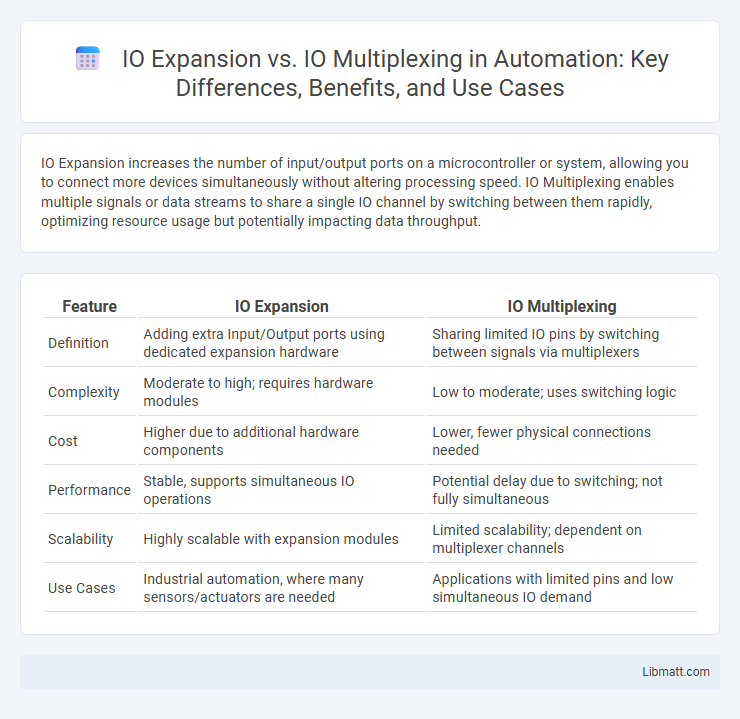IO Expansion increases the number of input/output ports on a microcontroller or system, allowing you to connect more devices simultaneously without altering processing speed. IO Multiplexing enables multiple signals or data streams to share a single IO channel by switching between them rapidly, optimizing resource usage but potentially impacting data throughput.
Table of Comparison
| Feature | IO Expansion | IO Multiplexing |
|---|---|---|
| Definition | Adding extra Input/Output ports using dedicated expansion hardware | Sharing limited IO pins by switching between signals via multiplexers |
| Complexity | Moderate to high; requires hardware modules | Low to moderate; uses switching logic |
| Cost | Higher due to additional hardware components | Lower, fewer physical connections needed |
| Performance | Stable, supports simultaneous IO operations | Potential delay due to switching; not fully simultaneous |
| Scalability | Highly scalable with expansion modules | Limited scalability; dependent on multiplexer channels |
| Use Cases | Industrial automation, where many sensors/actuators are needed | Applications with limited pins and low simultaneous IO demand |
Introduction to IO Expansion and IO Multiplexing
IO expansion increases the number of input/output ports available on microcontrollers or computers by using additional hardware components like shift registers, I/O expanders, or multiplexers. IO multiplexing optimizes limited IO pins by enabling multiple signals to share a single pin through time or signal division techniques, enhancing efficiency without increasing hardware complexity. Your choice between IO expansion and IO multiplexing depends on factors such as required pin count, cost, and system design complexity.
Understanding IO Expansion
IO expansion involves increasing the number of input/output pins available on a microcontroller or processor by adding external hardware such as IO expanders, allowing for direct control of additional sensors or devices. This method provides dedicated pins for each signal, minimizing latency and simplifying signal management compared to IO multiplexing. IO expansion is essential in applications requiring numerous discrete IO lines without compromising performance or increasing processor complexity.
Exploring IO Multiplexing
IO multiplexing enhances system efficiency by allowing multiple input/output operations to be managed concurrently through a single thread or process, reducing CPU overhead and improving responsiveness. Unlike IO expansion, which increases the number of physical IO ports or pins, IO multiplexing leverages software techniques such as select, poll, or epoll to monitor multiple file descriptors simultaneously. You can optimize resource utilization and handle large numbers of IO channels effectively with IO multiplexing in network servers and real-time systems.
Key Differences Between IO Expansion and IO Multiplexing
IO Expansion increases the total number of input/output ports by adding hardware components like I/O expanders or multiplexers, enabling more devices to be connected simultaneously. IO Multiplexing improves the efficiency of existing IO ports by sharing a single port for multiple input/output signals through time-division or signal multiplexing techniques. The key difference lies in IO Expansion physically increasing port count, while IO Multiplexing optimizes port utilization without additional hardware for new ports.
Advantages of IO Expansion
IO Expansion offers significant advantages by increasing the number of input/output ports available on microcontrollers and other devices without requiring additional processors, enabling more sensors, actuators, or peripherals to be connected. This method ensures dedicated pins for each device, improving signal integrity and simplifying software control compared to IO Multiplexing, which shares pins and requires complex timing management. Your projects benefit from enhanced scalability and straightforward hardware design when using IO Expansion.
Benefits of IO Multiplexing
IO Multiplexing enhances system efficiency by allowing a single thread or process to monitor multiple IO channels simultaneously, reducing the need for multiple threads and conserving CPU resources. It improves scalability in network applications by handling numerous connections with minimal overhead, making it ideal for high-performance servers. The approach also reduces latency and increases responsiveness by promptly detecting available IO operations without blocking.
Use Cases for IO Expansion
IO expansion is ideal for applications requiring multiple peripheral connections where microcontroller pin availability is limited, such as in industrial automation systems, robotics, and smart home devices. It allows for direct addition of input/output ports using hardware components like IO expanders (e.g., MCP23017), providing dedicated pins for sensors, switches, and actuators without increasing MCU complexity. IO multiplexing, while efficient for reducing pin count by time-sharing signals, may introduce latency and timing constraints unsuitable for real-time control or parallel device operation scenarios.
Applications of IO Multiplexing
IO Multiplexing is widely used in network servers, real-time data processing, and event-driven programming to efficiently manage multiple input/output streams simultaneously. It allows Your application to monitor multiple file descriptors, handling numerous connections without blocking, thereby enhancing scalability and responsiveness. This technique is essential for high-performance web servers, chat applications, and systems requiring concurrent socket communication.
Performance Comparison: IO Expansion vs IO Multiplexing
IO Expansion increases the number of input/output ports through additional hardware, offering predictable latency and consistent performance for systems requiring more physical connections. IO Multiplexing leverages software techniques like select, poll, or epoll to handle multiple IO streams on fewer ports, optimizing resource usage but potentially introducing higher CPU overhead as the number of connections scales. Your choice impacts system responsiveness, where IO Expansion suits applications needing stable throughput, while IO Multiplexing excels in scenarios demanding efficient management of numerous simultaneous IO operations.
Choosing the Right IO Solution for Your System
Selecting the right IO solution for your system depends on balancing the number of input/output pins and overall complexity. IO Expansion offers a straightforward method to increase the number of IO ports using devices like shift registers or IO expanders, ideal for systems needing numerous discrete inputs or outputs. IO Multiplexing optimizes pin usage by sharing physical lines for multiple signals, which reduces hardware requirements but may add design complexity and timing considerations.
IO Expansion vs IO Multiplexing Infographic

 libmatt.com
libmatt.com